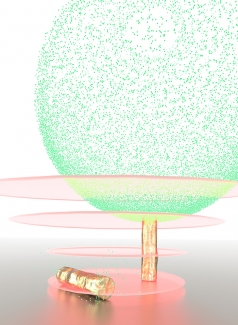The Nesbitt group has figured out the central role of “plasmon resonances” in light-induced emission of electrons from gold or silver nanoparticles. Plasmons are rapid-fire electron oscillations of freely moving (conduction) electrons in metals. They are caused by light of just the “right frequency.”
In metal nanoparticles, the right frequency exquisitely depends on the shape of the particle as well as its size and material. Master glass blowers actually figured this out during the Middle Ages! They learned to add tiny particles of gold and silver during glass making to produce the vibrant reds, blues, yellows, and purples of the stained glass windows in the great cathedrals of Europe. The tiny metal particles were not only responsible for the gorgeous colors, but have also prevented the hues from degrading over time, in some cases for more than a thousand years.
Today chemical physicists are working to understand the intricacies of plasmon resonances and their relationship to the photoelectric effect, which was first explained by Albert Einstein more than a hundred years ago. In the photoelectric effect, a photon of light of sufficiently high frequency will eject an electron from a metal surface. Even if the frequency of a single photon is not high enough to dislodge an electron, intense light can also cause electron ejection. Electron ejection occurs when the metal surface simultaneously absorbs several photons whose collectively energy is high enough.
This multiphoton photoelectric effect is particularly amazing since it usually takes three, four, or even more photons to eject a single electron. Then, if the frequency of the light hitting the metal surface happens to resonate with the metal surface’s plasmon oscillations, billions more electrons will be ejected than would normally occur!
This plasmon-induced photoelectron emission is the subject of intense scrutiny in the Nesbitt laboratory these days. Research associate Andrej Grubisic, former research associate Volker Schweikhard, recently minted Ph.D. Tom Baker, and Fellow David Nesbitt recently completed a study of the critical role of the intense electric field accompanying plasmon resonances in photoelectron emission. The presense of such plasmon resonances significantly increased the coherent multiphoton photoelectron yield from gold nanorods.
The researchers discovered that they could maximize electron emission from the gold nanorods if they (1) aligned the laser along the long axis of the nanorod and (2) used a laser whose frequency vibrated in sync with the plasmon oscillation. The combined effect of the laser’s frequency with the plasmon resonance created an electric field whose impact on the photoelectron emission from a gold nanorod’s surface was truly mind-boggling. The resulting light-induced emission rate of electrons increased by a factor of 10 billion!
These startling results bode well for future investigations of plasmon resonances and metallic nanoparticles in general. Such research is expected to yield such exciting, new applications as ultrashort-pulsed electron sources, more efficient solar cells, light-activated anticancer agents, high-density storage drives, and ultrasensitive chemical detectors. — Julie Phillips



 The Physics Frontiers Centers (PFC) program supports university-based centers and institutes where the collective efforts of a larger group of individuals can enable transformational advances in the most promising research areas. The program is designed to foster major breakthroughs at the intellectual frontiers of physics by providing needed resources such as combinations of talents, skills, disciplines, and/or specialized infrastructure, not usually available to individual investigators or small groups, in an environment in which the collective efforts of the larger group can be shown to be seminal to promoting significant progress in the science and the education of students. PFCs also include creative, substantive activities aimed at enhancing education, broadening participation of traditionally underrepresented groups, and outreach to the scientific community and general public.
The Physics Frontiers Centers (PFC) program supports university-based centers and institutes where the collective efforts of a larger group of individuals can enable transformational advances in the most promising research areas. The program is designed to foster major breakthroughs at the intellectual frontiers of physics by providing needed resources such as combinations of talents, skills, disciplines, and/or specialized infrastructure, not usually available to individual investigators or small groups, in an environment in which the collective efforts of the larger group can be shown to be seminal to promoting significant progress in the science and the education of students. PFCs also include creative, substantive activities aimed at enhancing education, broadening participation of traditionally underrepresented groups, and outreach to the scientific community and general public.